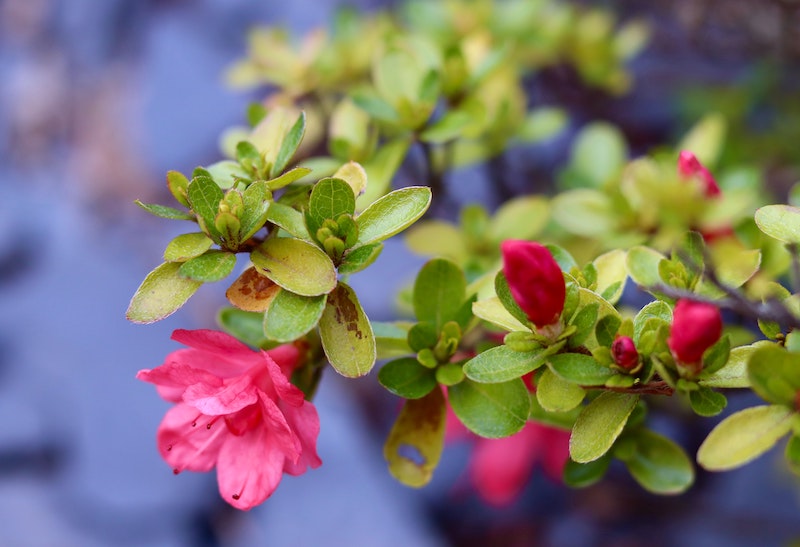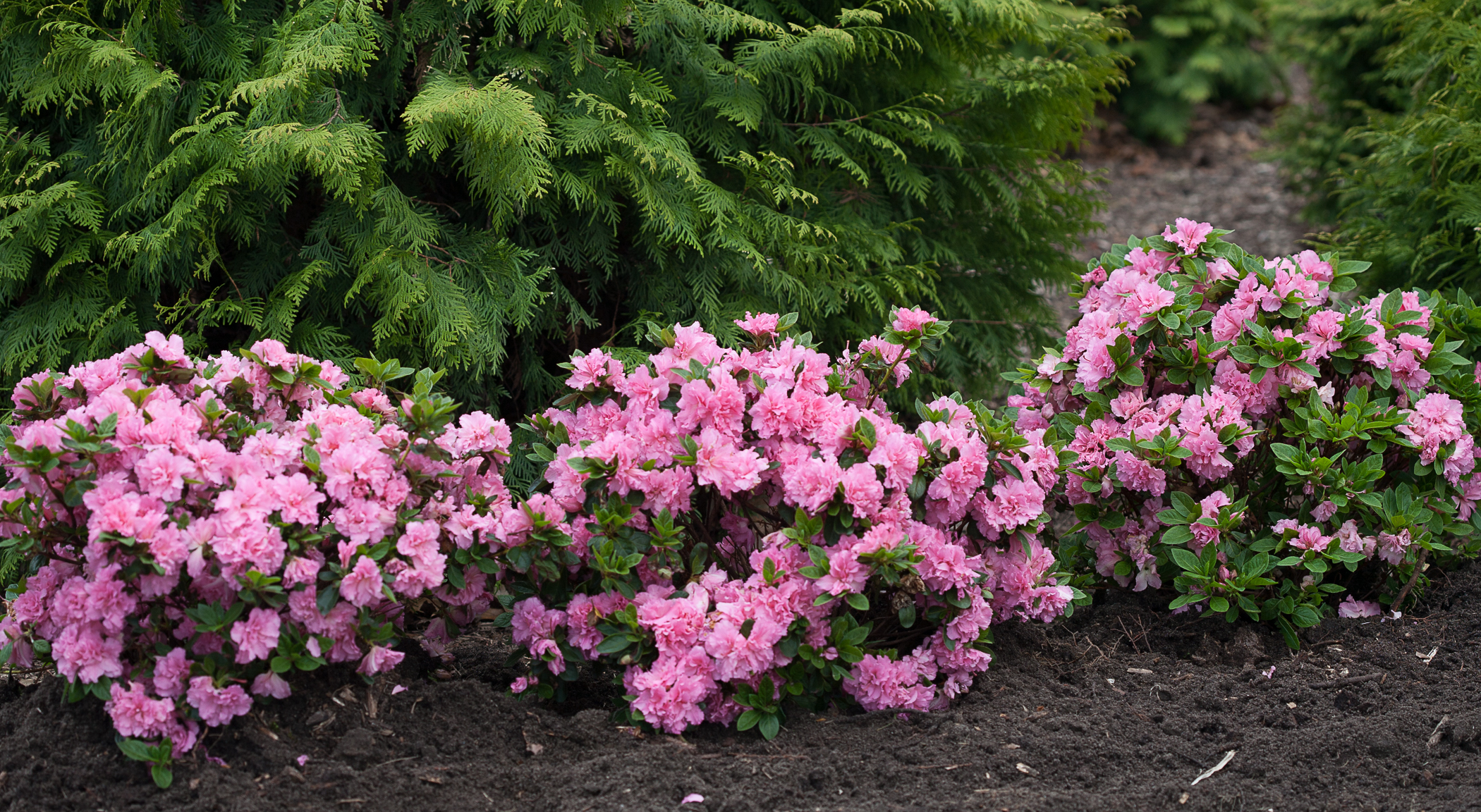Azaleas are in the Rhododendron family of shrubs and come in evergreen and deciduous varieties. Although larger animals such as deer and rabbits generally do not cause harm to established Azalea shrubs, there are some smaller pests that will cause cosmetic damage and at worst can kill plants if left unchecked. Azalea Lacebug, Leafminers, and Spider mites are known to cause mainly superficial damage to the foliage and are easily controlled with non-chemical treatments. Azalea Root Weevils and Barkscale are a much more serious threat to the health and longevity of the shrubs.

Common Azalea Pests
Azalea Lace Bug
Azalea Lace Bugs, scientifically known as Stephanitis pyrioides, are insects that cause superficial damage to the foliage, making leaves stippled and pale in color. The adults and nymphs both cause damage by sucking sap from the leaves and living on the undersides, resulting in a dark brown or black dirty look to the leaves. Heavily damaged leaves will fall off the plant. Evergreen types of Azalea are the most susceptible to damage, although the leaves may regrow over time. Several generations of Lace Bug are produced in a year with the first batch coming out of hibernation soon after the last frost of spring.
Treating Lace Bugs on Azaleas
Treating pests on plants should always begin with the least toxic method first. A strong jet of water from the hose can be used to wash off the undersides of the leaves. Repeat this method every week to control the Lace Bugs and kill off any hatching nymphs. The next step in treating Azaleas would be to use an insecticidal soap labeled for outdoor use. Following the directions, spray the undersides of the leaves well. The most effective time of year to use an insecticidal soap is early in the spring as the first generation of nymphs hatches. Spraying may need to be repeated on a 2-week schedule until the infestation is controlled. Using stronger, organic pesticides such as Safer BioNEEM or Monterey Garden Spray should be reserved as a last resort. Using a wide-spectrum pesticide is not advisable as it will also harm beneficial insects and pollinators.
Preventing Lace Bugs on Azaleas
The best prevention is to grow healthy plants that can defend themselves from pest attacks. Azaleas grown in the shade with acidic, well-draining soil will be much more resilient than those stressed by alkaline soil and intense sun. Over-fertilizing can produce lush, dense foliage that attracts sap-sucking pests such as the Lace bug. Fertilizing with a single application of slow-release food or mulching with organic compost early in the spring will help Azaleas grow strong root systems. Good garden hygiene is an absolute must to combat pests that hibernate in the soil or on the plants. Infected foliage needs to be removed and disposed of to prevent the Lace Bug from overwintering.

Azalea Leafminer
Leafminers, also known as Caloptilia azaleela, are caterpillars that are ⅛ - ¼ of an inch long and feed on the foliage, leaving behind brown, blistered spots. The older larvae skeletonize the leaves to the bottom layer of tissue, creating an almost translucent look. They also roll the leaves around themselves as they form silk. The larvae will find a fresh leaf to roll around itself and pupate, emerging as an adult moth ready to lay the next generation of Leafminers. Damage is confined to the foliage and is mainly cosmetic. A heavy infestation can cause excessive leaf drop that severely restricts the plant's ability to photosynthesize.
Treating Leafminer on Azaleas
The most effective way to control leafminers is to remove all infected leaves and squish the larvae inside the leaf. This method is good for treating small infestations. Larger infestations may need to be treated with chemical sprays. Organic sprays should be used after the Azalea is completely done blooming so that there will be no danger to pollinating insects. A ready to use (RTU) product such as Bonide Captain Jack’s Dead Bug spray should be applied according to the manufacturer's instructions. Usually two treatments, spaced 2-3 weeks apart, will control Leafminers.
Preventing Leafminer on Azaleas
Good garden hygiene is the best preventative for pests that overwinter as larvae and emerge in the spring. Rake up and dispose of fallen leaves around the shrub. Remove any leaves from evergreen Azaleas that appear to be rolled or skeletonized. Fertilize plants with a slow-release fertilizer formulated for acid-loving plants or apply a mulch of organic compost applied in late winter or early spring.
Azalea Spider Mites
Spider Mites, scientifically known as Tetranychus ssp., affect both indoor and outdoor plants as long as conditions are conducive for their survival. The small, pinpoint-size mites survive by sucking sap from the leaves of affected shrubs. The sap-sucking causes stippling and loss of color in the leaves. Extreme outbreaks can cause a rapid decline in the health of the shrub. Adults and nymphs are smaller than 0.02 inches and range in color from brown, green, red, and yellow depending on the species. Spider-like webbing of the leaves and branch unions may be seen in heavy infestations.
Treating Spider Mites on Azalea
Spider Mites can be controlled without chemicals if the infestation is caught early and there is relatively little damage to the shrub. A blast of water from a hose to the undersides of leaves can knock off any eggs and adults and disrupt the life cycle during a growing season. Organic chemical sprays such as Safer brand insecticidal soap can be used if the outbreak is heavy. A spot test should be done before spraying the whole plant. Evergreen Azaleas can be sensitive to soap sprays, which can result in further damage to the foliage.
Preventing Spider Mites on Azaleas
Outbreaks of pests or diseases only happen when a set of circumstances come together to allow the opportunity for infestation. Spider Mites attack plants that are growing weakly or struggling to stay alive due to environmental stress. Azaleas growing in alkaline (high pH) soil, poorly draining soil, or too much direct sun exposure are more likely to suffer from damage by even the smallest number of Spider Mites. Shrubs that have been stressed by extended drought or heat are also more susceptible to Spider Mite infestations.

Azalea Root Weevil
Root Weevils cause the most damage to Azaleas and Rhododendrons. They attack Azaleas in two ways. The grubs hatch from eggs laid at the base of the shrub and in the soil. These grubs eat layers of bark from the stems and trunks of the shrub, deep enough to disrupt the plant's ability to transport water and food. The wingless adults crawl from the ground into the canopy of the shrubs and eat away at the edges of the leaves, leaving telltale notches around the margins. This damage is most noticeable from June to August when the adults emerge under the cover of darkness.
Treating Root Weevils on Azaleas
Root Weevils affect many different species of plants and all cause similar damage. Identifying the specific Root Weevil is important when using chemical methods of control. All Root Weevils can be controlled mechanically by picking the adults off the leaves when they are active at night. The grubs can be picked out of the soil as you come across them during weeding or digging holes for other plants. A band of sticky Tanglefoot can be spread on the trunk a few inches up from the soil surface so adults can not climb into the shrub at night. Adults that cannot feed on the foliage will die, eventually preventing the next generation of grubs. Application of beneficial Nematodes can help control the grub population overwintering in the soil. Always follow the manufacturers' recommendations.
Chemical methods should be reserved only as a last resort for control. Using a broad-spectrum control is not recommended due to the harmful effects on beneficial pollinators and insects. Safer brand’s BioNEEM Concentrate can be used at the first sign of leaf notching. Apply the spray at night to reduce harm to beneficial insects and to make sure the nocturnal adults are fully exposed. Monthly applications may be needed until the Root Weevils are sufficiently controlled.
Preventing Root Weevils on Azaleas
The best way to prevent Root Weevils is to start with cultivars of Azalea that are less prone to infestation. The plants will note on their nursery tags if they have resistance. The next step is good garden hygiene. Clear away any debris from the base of Azaleas to prevent adult Weevils from overwintering or laying eggs for the next generation. Plant Azaleas in areas that have not been infected with Root Weevils and provide plenty of air circulation around the base of the shrubs. Prune back any bottom branches that lay on the ground. These low-growing branches provide a path for the wingless adults to make their way into the upper parts of the shrub.
Azalea Bark Scale
Bark Scale, also known as Acanthococcus (formerly Eriococcus) azaleae, is a nuisance pest that if left untreated can quickly turn into an infestation that is difficult to control. The small, 0.13-inch-long, adult scales live under cottony, white sacks along branches and in stem joints. The crawler and adult stage of the Scale are red and spend their whole life under the white, waxy residue. Adults overwinter on the plant, laying eggs that hatch early in the spring. Young crawlers are fully mobile and move around the shrub feeding on leaves and protecting themselves with the white, waxy residue. Two or more generations are produced a year.
Treating Bark Scale on Azaleas
The best way to control Bark Scale is to target the crawler stage. Wrap a sticky tape, with the sticky part facing out, around a branch of an Azalea with a suspected infestation. The red crawler will be easily visible in one to two days. Parasitic Wasps and Ladybirds feed on all stages of Bark Scale. Encouraging a balance of predator and prey in the garden is the best control. The Scale can also be rubbed off branches manually or controlled by cutting away any affected parts of the shrub. Dispose of infested plant parts in the trash or burn them. A home compost rarely gets hot enough to kill pests and diseases. As a last resort, an insecticidal soap may help to control Bark Scale. The most effective time to spray is from March to April, which coincides with the hatching season of the Crawler stage.
Azalea Pests Chart
|
Pest |
Identifying |
Treating |
|
Azalea Lace Bug |
Delicate, lace-like wings and distinctive black and white markings |
Wash off undersides of the leaves with a strong jet of water |
|
Azalea Leafminer |
Tiny, ⅛ - ¼ of an inch long, black-headed larvae |
Remove all infected leaves and squish the larvae |
|
Azalea Spider Mites |
Small, pinpoint-size mites |
Remove any eggs and adults with a blast of water spray |
|
Azalea Root Weevil |
Small, dark-colored beetles with elongated, snout-like mouthparts |
Pick the adults off the leaves when they are active at night |
|
Azalea Bark Scale |
Red and lives under a white, waxy residue |
Rub off branches manually and control by cutting away any affected parts |
Sources:
"Azalea and Rhododendron Insect Pests." Clemson University Cooperative Extension Service. hgic.clemson.edu
"Pests of Azalea." N.C. Cooperative Extension. content.ces.ncsu.edu
 |
Author Robbin Small - Published 04-04-2023 |
